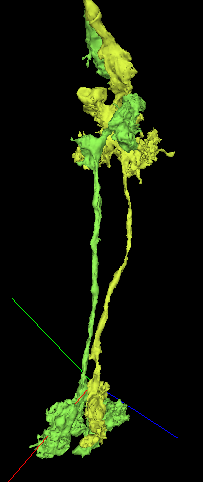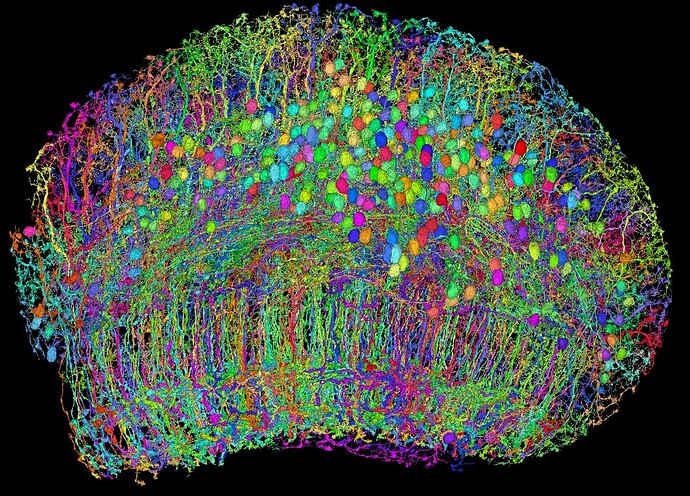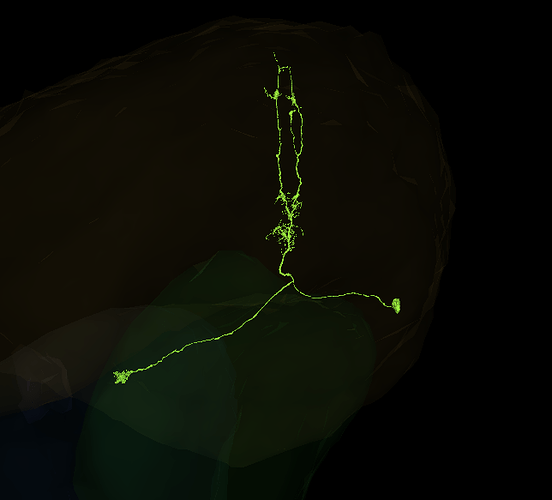Here are some labeled Lat (lamina tangential) cells! ![]()
https://ngl.flywire.ai/?json_url=https://globalv1.flywire-daf.com/nglstate/5822216144945152
Awesome!
I didn’t realize, they span all the way to the CB. Also, I thought, each of the main neurites between M and La will go separate way, not as a single bunch.
I have another “type doesn’t exist” problem.
I was able to identify Y1, Y4, Y11 and Y12 cells.
Y2, Y7-Y10 don’t exist.
That leaves us with Y3, Y5 and Y6.
I’ve found almost 300 Y cells other than those already identified, but they all look the same:
https://ngl.flywire.ai/?json_url=https://globalv1.flywire-daf.com/nglstate/5086231706730496
According to the Fischbach’s paper they should be most distinctive in their lobula extensions, but I don’t see any differences.
Also, of these 3 types, Y5 and Y6 are mentioned only in the Fischbach’s paper.
So, I’m starting to think, all these three types are a one type.
i am not able to see any differance either, but it do look weird that it it 300 cells left in one type when the other Y- cells have only 60-90 cells
I agree, that looks a little unusual, however, I’ve seen similar behaviour elsewhere. For example, some Mi cells are one per ommatidium, so about 800 cells, but others are only one per two columns or even one per 10 columns.
What suggests me, that it might be a single type, is how they look both in the medulla and in the LOP - they fill the planes nicely, without overlapping or creating patterns constructed of 2-3 cells.
I’ll look at them some more, maybe I’ll find some more info to help me decide, what to do.
While going through my T-cell farms, I came across this previously completed but unidentified neuron. It has most characteristics of a T2 or T3 cell - I’d be more inclined to call it a putative T2 because it stretches further than a T3 would - but there’s clearly something different going on with a split here in the medulla and a lack of expected branches. Any thoughts? I’ve tried looking on the forums best I can but “T2” is too short a search term and we’ve posted so much over the past year!
Edited to add another example cell to the link below -
https://ngl.flywire.ai/?json_url=https://globalv1.flywire-daf.com/nglstate/5715177741746176
It so happens, that I’m currently working on T2 cells. If we assume, that everything, that has big-small-big arborizations in the medulla are T2 and every other type is a T2a, I’d say, yours is a T2a.
Here are all T2/T2a cells, I’ve found so far (probably some others between them, I still have to filter them out): FlyWire (warning over 1000 cells, almost 30k chunks). You can see, there are many with this split top branch.
Thank you! So it seems like I’m on the right trend with T2-type. I feel like there might be more distinctions here than T2 and T2a that just haven’t been investigated yet. That of course will take more time and research to figure out, if so, but I will label these putative T2 types ![]()
Im having a bit of trouble deciding between two cells to label as an L1. Tbh im not sure if maybe both of them are, but there should only be one per column, so ![]()
https://ngl.flywire.ai/?json_url=https://globalv1.flywire-daf.com/nglstate/5365430300442624

I’ve added to the link the L2-5 for the column and a “proper” L1 from another column for reference, with annotations to clarify.
If I could take the lower cluster from one and the middle cluster from the other, i’d be happy ![]() Maybe this column just has two malformed L1s?
Maybe this column just has two malformed L1s?
(Edit: Found a second pair, only these two pairs across the whole lobe though. FlyWire)
I’m going to ask around, but it could be that these are just some odd ones. I couldn’t find any extensions that would indicate that one of these was a different type of cell (ie. centrifugal cell, etc.).
We know that for the photoreceptors (R-cells) that “because of neural superposition during eye development, there is atypical number of photoreceptors at the equator and edge”. While I’d say the second pair you shared is closer to the edge of the medulla compared to the first pair, this could explain why there may be an extra L1…

